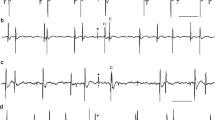Summary
When the sensory fibres in “Rana Esculenta” are stimulated with trains of square pulses, having a duration of 100 μsec, with frequencies between 20 and 100 Hz, the T-shaped cells of spinal ganglia (which are electrically excitable and respond to low frequency stimulation producing an action potential) are progressively affected by fatigue. For this reason the cellular spike (S spike) is generated with an increasing delay after the non-myelinated (NM spike) and myelinated (M spike) component of the action potential.
In the fibre very often a new spike becomes evident, under such stimulation modes, in addition to the action potential generated by the external stimulus. This one follows the former with a varying delay, depending on the position of the microelectrode in respect to the ganglion.
The second impulse, when it appears, shows similar characteristics to those of the retarded cellular spike, under conditions of fatigue, both as regards the frequency values at which it appears and the intermittance of the response.
Assuming that the second spike could be attributed to an influence of the soma, we have developed a series of experiments in order to verify this assumption.
Similar content being viewed by others
References
Bairati, A.: Trattato di Anatomia Umana, Vol. 3, pp. 66–67. Ed. Minerva Medica (1971)
Coombs, J. S., Curties, D. R., Eccles, J. C.: The interpretation of spike potentials of motoneurones. J. Physiol. (Lond.)139, 198–231 (1957)
Coombs, J. S., Curtis, D. R., Eccles, J. C.: The generation of impulses in motoneurones. J. Physiol. (Lond.)139, 232–249 (1957)
Crain, S. M.: Resting and action potentials of cultured chick embryo spinal ganglion cells. J. comp. Neurol.104, 285–329 (1956)
Dun, F. T.: The delay and blockage of sensory impulses in the dorsal root ganglion. J. Physiol. (Lond.)127, 252–264 (1955)
Ha, Hongchien: Axonal bifurcation in the dorsal root ganglion of the cat. A light and electron microscopy study. J. comp. Neurol.140, 227–240 (1970)
Ito, M.: The electrical activity of spinal ganglion cells investigated with intracellular microelectrodes. Jap. J. Physiol.7, 297–323 (1957)
Ito, M.: An analysis of potentials recorded intracellularly from the spinal ganglion cell. Jap. J. Physiol.9, 20–32 (1959)
Ito, M., Saiga, M.: The mode of impulse conduction through the spinal ganglion Jap. J. Physiol.9, 33–42 (1959)
Lenhossék, M. v.: Untersuchungen über die Spinalganglien des Frosches. Arch. mikr. Anat.26, 370–453 (1886)
Svaetichin, G.: Analysis of action potentials recorded from single spinal ganglion cells. Acta physiol. scand.24, suppl.86, 23–57 (1951)
Tagini, G.: Aspetti del potenziale d'azione nelle cellule dei gangli spinali di rana. Boll. Soc. ital. Biol. sper.47, 130–132 (1971)
Tagini, G.: Risposta delle cellule di gangli spinali di rana a stomili di diversa frequenza. Boll. Soc. ital. Biol. sper.47, 132–133 (1971)
Tagini, G., Camino, E.: Alterazioni del ritmo degli impulsi sulle vie sensitive ad opera delle cellule a T dei gangli spinali. Boll. Soc. ital. Biol. sper.48, 355–356 (1972)
Tauc, L.: Site of origin and propagation of spike in the giant Neuron of Aplysia. J. gen. Physiol.45, 1077–1097 (1962)
Tauc, L.: Identification of active membrane areas in the giant Neuron of Aplysia. J. gen. Physiol.45, 1099–1115 (1962)
Author information
Authors and Affiliations
Rights and permissions
About this article
Cite this article
Tagini, G., Camino, E. T-Shaped cells of dorsal ganglia can influence the pattern of afferent discharge. Pflugers Arch. 344, 339–347 (1973). https://doi.org/10.1007/BF00592786
Received:
Issue Date:
DOI: https://doi.org/10.1007/BF00592786




